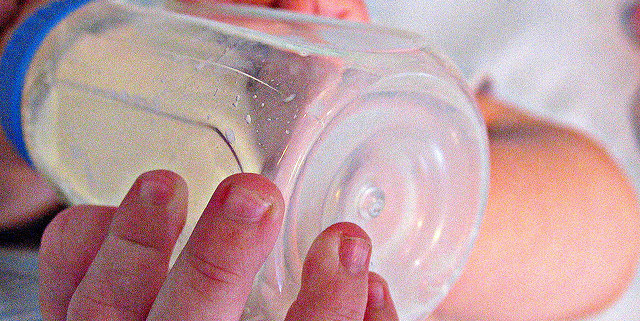Feeding Baby: Breast Milk vs. Formula
 While adults get the nutrition they need by eating a well-balanced diet, babies eat only one thing – breast milk or formula. That’s the sole source of the calories, vitamins, and other fuels they need to grow and develop. Historically, breastfeeding was the only option. Other alternatives, from plain cow’s milk to mixtures of flour and water, were developed and tested over time as potential substitutes. Formula as we know it became very popular in the 20th century, but the pendulum started to swing back toward breastfeeding in the 1970s. Now, about 77% of babies are breastfed. So, what’s the difference? And what’s right for your baby?
While adults get the nutrition they need by eating a well-balanced diet, babies eat only one thing – breast milk or formula. That’s the sole source of the calories, vitamins, and other fuels they need to grow and develop. Historically, breastfeeding was the only option. Other alternatives, from plain cow’s milk to mixtures of flour and water, were developed and tested over time as potential substitutes. Formula as we know it became very popular in the 20th century, but the pendulum started to swing back toward breastfeeding in the 1970s. Now, about 77% of babies are breastfed. So, what’s the difference? And what’s right for your baby?
Contents
What’s In Breast Milk?
Breast milk is one-stop shopping for all of your baby’s nutritional needs – it’s a powerful combination of proteins, fats, vitamins, and carbohydrates. In addition to providing needed nutrients, proteins such as lactoferrin, secretory IgA, lysozyme, and bifidus factor help prevent certain infections and build your baby’s immune system. The carbohydrates and fats give your little one energy; the fats are also crucial for healthy development of the nervous system. Breast milk also contains leukocytes, living cells that help fight infections.
What’s In Formula?
Formula is designed to act as a substitute for breast milk; it’s intended to offer all the same nutritional benefits. There are 3 main types available: cow milk-based, soy-based, and protein hydrolysate-based. There are also certain specialty types of formula available for babies who are born prematurely or who have certain health problems. Cow milk formulas are the most common; they’re simply made from cow milk and adjusted to more closely resemble human milk. Some babies are allergic to the proteins or lactose found in cow’s milk, so soy milk formula offers an alternative. Babies with sensitivities to both cow’s milk and soy milk may need protein hydrolysate formula, in which the proteins are broken down so they’re easier to digest.
Breastfeeding Basics
Breastfeeding seems fairly simple – bring the baby to the nipple and let the magic happen! However, it’s not necessarily that simple. Some babies will nurse right away, while others will need to be encouraged. It will also take some getting used to on your part – you’ll need to find comfortable positions and adjust as your breasts ramp up milk production. You’ll produce more milk the more your little one nurses, so you can nurse whenever your baby wants to. Typically, babies want to feed every couple of hours – 10-12 times a day.
Your baby’s doctor will keep an eye on the scale to make sure the baby is gaining enough weight. All babies lose some weight over the first few days of their lives, but thereafter should gain around an ounce every week. If your baby isn’t gaining weight fast enough or is losing weight, your doctor may recommend that you supplement your breast milk with formula to provide some extra calories. Your doctor may also recommend that you keep taking prenatal vitamins or take a vitamin D supplement to ensure that your little one is getting the right nutrition.
When you’re going to be away from your little one during a feeding, you can pump breast milk in advance and save it. There are a number of types of breast pump on the market and you may need to experiment with a couple to find one that’s comfortable for you. Pumped milk will need to be refrigerated and re-heated when it’s time for baby to eat.
Formula Basics
There are 3 different types of formula – powdered, concentrate, and ready-to-use. You’ll need to mix the powder or concentrated liquid versions with water and warm it up for your little one. The ready-to-use version just needs to be warmed. There are a number of different brands and types of formula available, and you may need to try a couple before you find one your baby likes.
Whether you’re breastfeeding or using formula, your doctor will monitor your little one’s weight and may recommend adding a concentrated formula or feeding the baby more often to achieve healthy weight gain. If the formula you’re using doesn’t already include a vitamin D supplement, your doctor may recommend adding one.
Which Is Better: Breastfeeding Or Formula?
So, is one of these options better than the other? The American Academy of Pediatrics (AAP) and the American Medical Association (AMA) recommend breastfeeding if possible because breast milk contains unique antibodies and proteins that help your little one’s immune system develop. Breastfeeding is also associated with a number of other health benefits, included a decreased risk of obesity, asthma, diabetes, high cholesterol, and certain types of cancer later in life. Finally, breast milk is often easier for babies to digest than formula. Breastfeeding also has certain benefits for the mother – you’re pouring a lot of calories into your breast milk, making it easier to drop the pregnancy weight. It’s linked to a decreased risk of breast, ovarian, and endometrial cancers and improved recovery of the uterus.
However, breastfeeding isn’t an option for everyone. Some women don’t produce enough milk and some find breastfeeding to be extremely uncomfortable or even painful. Some have schedules that don’t permit breastfeeding or pumping. Whatever the reason, formula is also a safe and effective food source for your little one. In many cases, it’s substantially more convenient – you don’t have to refrigerate the powdered version and anyone can feed the baby.
At the end of the day, the choice will depend on your needs and the needs of your baby. Breastfeeding is linked to certain health benefits, but it’s not always the best choice. You’ll need to work with your doctor and your family to decide what’s right for you. Also, remember that it’s not an all-or-nothing choice – you can use both formula and breast milk if that’s what works best for you.
How did you decide to feed your little one? Tell us about it in the comments!
Image Credit and License








Leave a Reply
Want to join the discussion?Feel free to contribute!